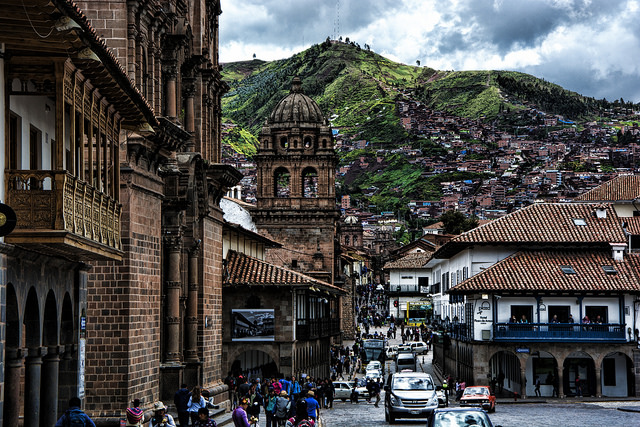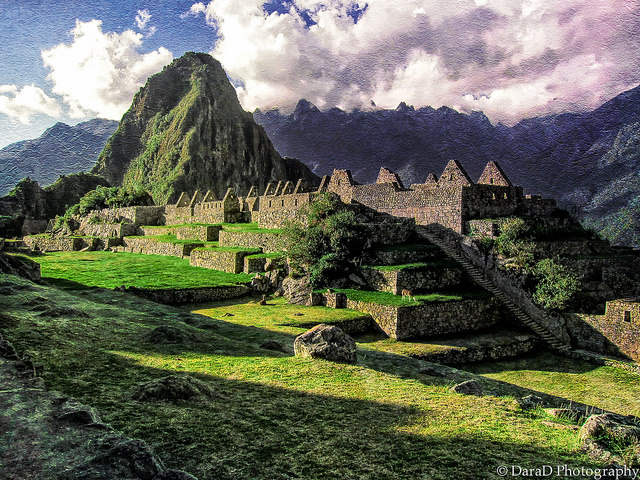Cuzco is a southeastern Peruvian city, near the Urubamba Valley of the Andes mountain range. It is the capital of the Cusco Region as well as the Cusco Province. Cuzco is a fascinating location that was once the capital of the Inca Empire. Today Cuzco is a UNESCO World Heritage Site and is one of Peru’s most visited cities as it is the largest and most comfortable location from which tourists can begin visits to Machu Picchu, the Sacred Valley of the Incas, and other Inca sites in the region.

Image courtesy of Mariano Mantel at Flickr.com
History
Cusco is an amazing city filled with spectacular colonial architecture as well as a rich a complex history. The city is representative of the indigenous Quechua culture in the Andes, something that will become quite evident as you walk the streets and soak in its atmosphere. The city is surrounded by numerous archeological sites and ruins of what the Incan Empire once was.
How Cusco was specifically built, or how its large stones were quarried and transported to the site remain undetermined. It is said that the large stones and the plans that give shape to the city, were meant to have the form of the sacred puma. According to Inca legend, the city was rebuilt by Sapa Inca Pachacuti, who transformed the Kingdom of Cuzco from a sleepy city-state into the vast empire of Tawantinsuyu. Eventually general Atahualpa gained control of the city and nineteen months later, the Spanish explorers arrived and invaded the city and after many years of conflict, ended what we know as the Incan Empire.
Machu Picchu
Machu Picchu is the site of an ancient Inca city, high in the Andes of Peru, often called “The Lost City of the Incas”. Discovered in 1911, Machu Picchu is one of the most amazing symbols of Incan culture and a visit to Peru would be incomplete without seeing it.
The Spanish explorers completely missed the site and were never able to plunder it. The city is highly protected by its strategic location up in the mountains forcing travelers to walk through valleys littered with Inca checkpoints and watch towers. The exact purpose of Machu Picchu within Inca life remains mostly unknown; the place may have been of religious significance or perhaps some sort of resort for elite Incas.
Only 2,500 people are allowed to enter Machu Picchu each day. In the low season it shouldn’t be a problem and you should be able to buy your ticket at the last minute. During high season it fills up quickly and you might need to buy your ticket in advance.

Image courtesy of Dara at Flickr.com
Lake Titicaca
The lake is located on the border between northern Bolivia and southern Peru. It is considered the highest commercially navigable body of water in the world and the largest lake in South America.
Ollantaytambo
This religious center doubled as a fortress during the Spanish conquest. Great place to visit on the return from Machu Picchu or an alternative if you don’t want to visit Machu Picchu.
Qorikancha
In Inca times, Qorikancha (Quechua for ‘Golden Courtyard’) was literally covered with gold. The temple walls were lined with some 700 solid-gold sheets, each weighing about 2kg. There were life-sized gold and silver replicas of corn, which were ceremonially ‘planted’ in agricultural rituals. This temple is one of those sites that you cannot leave Cuzco without visiting.
La Catedral
This is the mother church of the Roman Catholic Archdiocese of Cuzco. The cathedral is located on the Plaza de Armas. Building was completed in 1654, almost a hundred years after construction began. The cathedral was designated a UNESCO World Heritage Site under the City of Cuzco listing in 1983 and today it holds many archeological artifacts and relics.
Gastronomy
As capital to the Inca Empire, Cusco was an important agricultural region. It was a natural reserve for thousands of native Peruvian species, including around 3,000 varieties of potato cultivated by the people. Peru’s steady gastronomic ascent over the past 15 years has accelerated to a rapid boom, a source of national pride and a motor of the economy as increasing numbers of tourists head here to sample the original and varied cuisine. The dishes span everything from Peruvian-Japanese fusion to pachamanca, a pre-Colombian classic of slow-cooked meats and vegetables. Food in Peru is slowly overtaking the Inca heritage as the main reason for people to visit this magical land. No other cuisine in South America is as diverse, delicious and celebrated as Peruvian food.
For a great place to stay, look no further than Hotel Midori. This beautifully restored colonial house has everything you need and more. Strategically located in the historic center of Cusco, you will be close to the best restaurants, museums, traditional shops and all other beautiful sights the city has to offer.
Check out our other articles on the best destinations to visit, at Royal Holiday Destinations.

